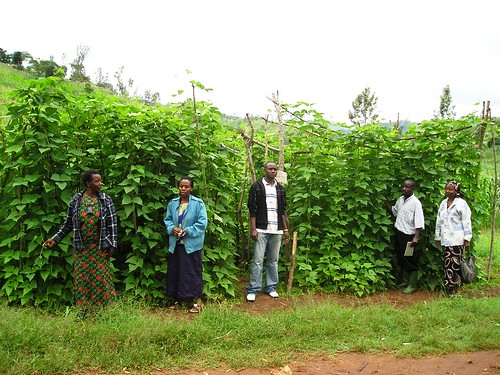Climbing beans doubling yields in Tanzania
Climbing beans are turning out to be one of the winning innovations being introduced by Africa RISING in Babati district, Tanzania. The beans have tendrils which coil around supporting stakes or strings and can grow as high as 2 meters tall and produce many pods and leaves.
According to Edgar Lyakurwa, an extension officer with the Ministry of Agriculture Food Security and Livestock for Babati, farmers in Seloto and Long villages were amazed at the high yield of climbing beans that were grown for demonstration in 10 farmers’ fields. They are also harvested over a long time providing continuous food for the family.
“Farmers love the climbing beans because they are able to harvest them more than once compared to the normal bush beans they grow,” he said. “The beans are tied either to a stake or a string and can grow as tall as a person. The farmers start harvesting the pods from the bottom and they can continue harvesting for even up to one and half months,” he explained.
He added that the beans have many leaves and help protect the soil cover and also enrich it with organic matter.
Rich in proteins, beans are one of the important crops for the communities living in Babati who boil it with maize to make their local dish “makande”. They are also an important source of income. The beans also help to enrich the soils though nitrogen fixation.

The climbing beans yield nearly twice as much as the ordinary beans the farmers are used to growing, says Festus Ngulu, one of the project staff from IITA. “You can compare climbing beans to constructing a multi-storey building. It makes efficient use of apical space to accommodate more people within a unit area as compared to a single- storey unit,” he said.
He says to maximize the yield potential, the farmers are encouraged to stake as early as 10–14 days after emergence of the seedling. The stakes are inserted into the soil close to the young plants whose tendrils coil around the stakes for support to the stems as they grow upwards. Alternatively, farmers can use string tied to poles instead of the stakes.
This component of the project is being handled by the International Centre for Tropical Agriculture (CIAT) in collaboration with the Selian Agricultural Research Institute (SARI).
Story by Catherine Njuguna (IITA)
This story was published as part of an Africa RISING special issue of the IITA Bulletin (1 August 2013)




